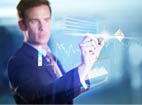
How to Evaluate Predictive Analytics for Your Business

Following up on my post on chip-level developments in machine learning (ML), there is no question that the technology will have a profound effect on IT and business-side processes like CRM and ERP. But exactly how will things change, and will it necessarily be for the better?
The media is full of accounts of how machines will take over everything eventually, from the most mundane file organization to complex judgement calls. They learn, after all, so as they become proficient at the simple tasks, they are gathering the information they need to do the complex ones.
But as experience with the technology grows, it turns out that machines can only learn in a fairly limited fashion and their true potential for mastering higher-order functions is largely theoretical. Ovum’s Tony Baer noted on ZDnet recently that while Google has implemented machine learning to a fairly large extent on its Google Cloud Platform, most of its capabilities are directed toward consumer applications like search and maps. For the enterprise, it has shown some success in app development, particularly in areas like speech recognition and language translation, but it is nowhere near the point where it can support the company’s NoOps vision of fully automated infrastructure management. The same can also be said for the ML capabilities of Amazon, Microsoft and even IBM.
Still, it’s the potential for ML to assume much of the day-to-day responsibilities of the enterprise that drives most of the concerns among the knowledge workforce, particularly as legions of connected devices push data and infrastructure management beyond human capabilities. As ReadWrite’s Shuvro Sarkar points out, applications span the gamut from predictive maintenance and inventory control to market creation and optimization. Ultimately, however, ML has the ability to improve the accuracy and timing of critical data sets – not necessarily to take over the decision-making process but to provide deeper insight into the choices that present themselves.
Understanding how ML actually works goes a long way to seeing how it will and will not affect technology and business processes, says analytics consultant Thomas Dinsmore. At the heart of every solution, of course, are the algorithms that convert raw data into valuable knowledge, which can then be interpreted by humans, other machines, or both. As can be expected, this can be accomplished in dozens of ways, and results can vary depending on which frameworks, assumptions and other criteria are applied to data. In general, however, a successful implementation will accomplish four key goals:
- Identify complex interactions among variables.
- Learn low-level features from raw data.
- Predict high-cardinality class memberships, such as in image classification.
- Work with unlabeled data, such as bit-mapped images.
At the moment, however, most organizations are focused on developing machine learning models for their MPP and Hadoop clusters, and perhaps even some legacy SAS platforms. But the real challenge will be deploying them into production environments, says Alpine Data’s Josh Lewis. From mapping the dependencies for all the points that ML will touch to executing the real-time inferences across data streams, the level of complexity involved is orders of magnitude greater than for today’s typical batch job. As well, organizations will have to overcome the preference of data scientists to use multiple tools, such as R, Python and Spark, versus ML’s need for a single representation of compute tasks. The best way around this would be a standard, language-agnostic deployment model that can accommodate a broad range of algorithms, something that the Data Mining Group is currently working on in its Portable Format for Analytics (PGA) program.
Will machine learning be transformative in the enterprise? Most definitely. Will it lead to fully autonomous data processes that will make IT, and the white-collar workforce in general, obsolete? Not likely. While it does have the capacity to assume many of the hands-on management responsibilities that human technicians currently perform, plenty of tasks are still uniquely suited to electro-chemical intuition and cognition.
Going forward, the task will be to determine the optimal means of leveraging all of the enterprise’s intelligent assets.
Arthur Cole writes about infrastructure for IT Business Edge. Cole has been covering the high-tech media and computing industries for more than 20 years, having served as editor of TV Technology, Video Technology News, Internet News and Multimedia Weekly. His contributions have appeared in Communications Today and Enterprise Networking Planet and as web content for numerous high-tech clients like TwinStrata and Carpathia. Follow Art on Twitter @acole602.











